RDN, Visby, Gotland and Gudrun Sjödén….
I had four great days in and around the Hanseatic League city, Visby, and its island of Gotland. As the new Gudrun Sjödén catalogue says: the island is a symphony of greys. Visby, though, is vivid, and brilliantly coloured. It has plenty of Farrow and Ball chic, but also bags of winter-defying gaudiness. (All in the best possible taste, of course.) Here’s a brief guide…
Visby, first, then. (The rest of the island of Gotland, below.)
This is a perfect medieval city. It’s a trading relic: merchant’s houses, warehouses, battlements – and an excellent Co-op in a shopping plaza just beyond the walls. Visby has a special status in Sweden’s thinking, and perhaps especially Stokholm’s (being a short flight or ferry ride from the capital).
It’s a place of what looks close to a sort of national pilgrimage. Within the walls, it’s been preserved in something like Disney’s aspic. One could think Carcassonne, or Mont St Michel. One would say that there’s quite a lot of Venice in the mix: but Visby does not convey very much decadence. Good honest trade and shipping; money being made; but not many courtesans. Its art gallery, for instance, is comically thin on anything like old paintings, and what there are seem to be the rescued work of a castaway 19th century Englishman. Its modern exhibits were the worst sort of Euro-normal installation tosh.
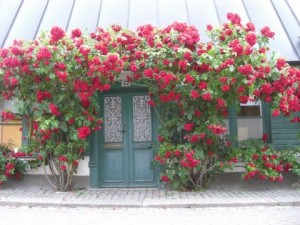
Visby front door
There is an element of Southwold: people of sufficient means and niceness live in small, exquisite houses, and in the erstwhile cottages, hovels and bothies of the old city’s less fortunate. It so remarkably elegant and pretty by turns that a harbour full of white plastic motor-yachts adds a dash of welcome vulgarity without denting the ambiance.
I was there in July, during the annual political festival which sees Sweden’s PR and political elite strutting their stuff in what looks like all our separate party jamborees rolled into one. At the time, I speculated mildly on the thriller-writing prospect of a bit of Wallander-cum-Dragon Tattoo girl mayhem unfolding here; events in Norway were to make that seem tasteless. The city was heaving with expense-account diners: one’s finding it difficult to get a table was ameliorated by the sheer delight in such overt recession-beating, cheerful good-timing. And everyone was so damned good-looking, which helps.
The weather was heavenly, and I found myself swimming from a jetty just by the deep water harbour. Such places are where any maritime town shows its best: its muscle marys and good old girls, its young families and wrinkly old men (one so prefers those who know that Speedos only look unpervy on the under-thirties). The water was nearly warm: the brochures say that the sea here is clement, and often reaches bathing temperature by late August. Visby is built on the side of a hill: dropping down to the harbour or striding back up steps and slopes added a welcome mild theatricality to a dip.
As to restaurants. They say there is only one fish restaurant in Visby. It’s not quite true, but there is a simplicity about Bakfickan which is certainly distinguished. They didn’t have the fish soup when we went, which reduced us to lovely things done to prawns, smoked salmon and herring. It’s minimalist stuff, but served so beautifully on the pavement or inside that one knows one’s place.
For a more intense sort of decorative thrill, there is a quayside fish restaurant, Österdahls Brygga,
in what one imagines might have been a customs office or a crew room. ((Telephone 0498 21 77 88. For location, try Visby Hamn in Google maps and hone in on the large round structure at the top right of the harbour: it’s a spit from that.) This small room is almost heart-breakingly pretty: full of light, plain linen, candles. The food is simple and even austere. For starters I had a dish described as “three kinds of herring”, and there was certainly some difference between each of the fillets, and more between the three sorts of sauce draped over each.
I very nearly took the whole thing seriously. Or rather, something odder happened. I remembered to be amused, but was actually swept up, as though I had stepped momentarily into a sort of Babbette’s Feast, and this was perhaps an item on the taster menu. And at the outside tables there were sun-tanned, well-off people off yachts; and then a gnarled photographer from a city paper, with a Leica on a thong around his neck, had something even simpler than I had and left; and the waitress on her way to Barcelona to advance her career; and all the time the owner, precise and quiet, dipping, arranging, clipping, was central to proceedings with a complete absence of assertion. He didn’t flinch when someone dropped something in the kitchen. I saw no sign of anything which could be called cooking: maybe the chef did not like to have his hair smell.
Walking away from that supper, I very nearly topped-up with a bratwurst from the brilliant snack-stand at the harbour’s northern end. But one of those for lunch is quite enough when one is in Visby-mode.
We didn’t go to any of the full-on upmarket places, nor to the zillions of routinely gorgeous, cheerful spots which litter the town. They all looked as though they delivered exactly and decently what their price range was capable of. We had a brilliant steak (on offer everywhere) at Restaurant Celine, a place which was a little more, well, ordinary, on the main pedestrianised shopping street in the upper town. It was almost restful to find it wasn’t on parade in quite the Visby way.
The poor bloody English find Swedish, let alone Visby, prices a little intimidating. £7.50 for a glass of wine, etc. Remember, Scandinavia’s always expensive and at this moment the exchange rate makes things hurt additonally. But don’t fuss, scale back, and one sort of manages to feel decently-done-by, and that’s the real point.
Gotland, beyond Visby
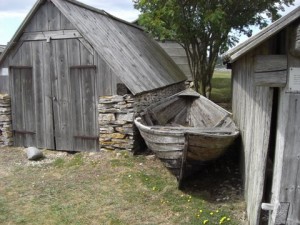
Kovik fishing station museum, Gotland
This isn’t magnificence and nor are there granite skerries and bleak moorland. The island is sandy tracks down to summer huts and pebbly beaches and jetties. In some spots, there are wider marshes, in others, there are woodlands which are a little wet underfoot. Killing half an hour near the airport, I found a sunny glade with cotton grass, sedges and orchids. I was so chilled-out, I didn’t mind the notice board with all the species photographed and named.
Almost every road was fringed by a profusion of wild flowers: tall, dazzling; waving as cars sped by. I should perhaps mention that ours was a rent-a-wreck from a business based at the airport. Maybe a third or half the normal price, our red Fiesta had been loved or joy-ridden nearly to destruction, but the essential equipment worked even if the radio and the cigar lighter didn’t. Highly recommended.
We ran south, dropping by unamed beaches, and lunched at the fabulously unpretentious timber port of Klintenhamn, where – amongst “project” wooden boats in every state of neglect and restoration – there was a lovely habour cafe with crepes filled with some local fruit which looked
sort of blackberry-ish but apparetly wasn’t. And then on down to the church at Frojel: plain and Calvinist one might think; but then inside there is just that flash of candelbra and crucifix which lets one know why Swedish taste is for a plain canvas with one splash of the roccoco. Every pew had a minute corsage and the garden was being tended by a bent crone who spoke – refreshingly – no English which she was prepared to waste on us.


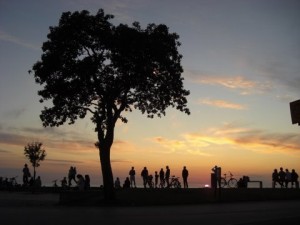
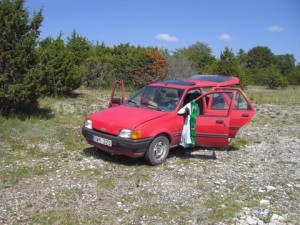
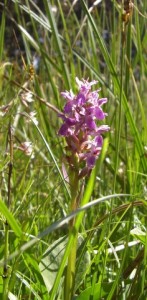
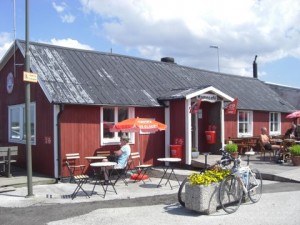
24/09/11